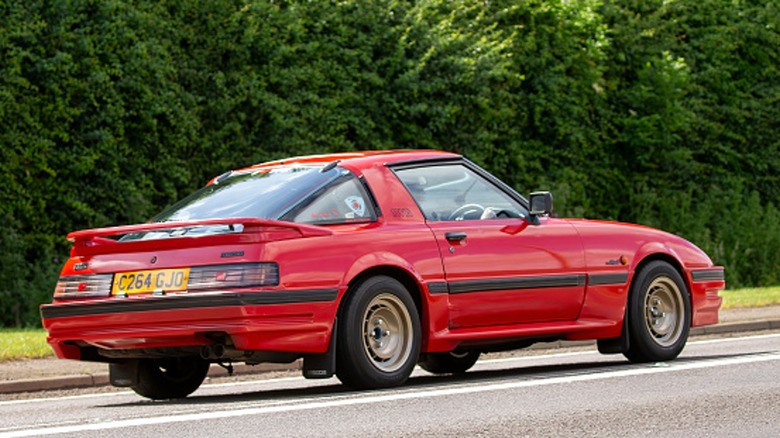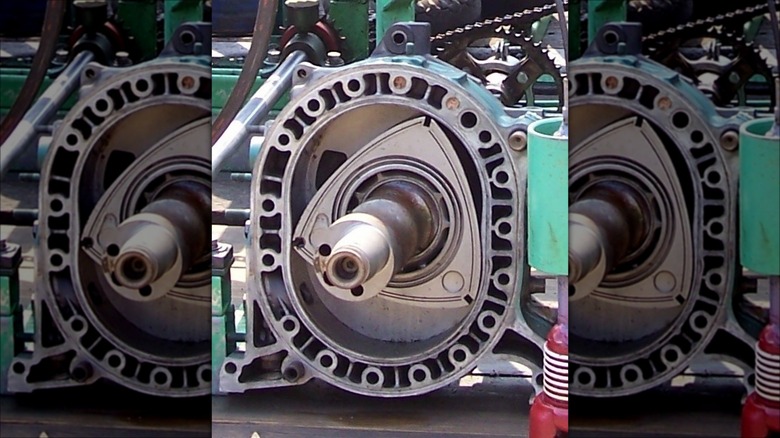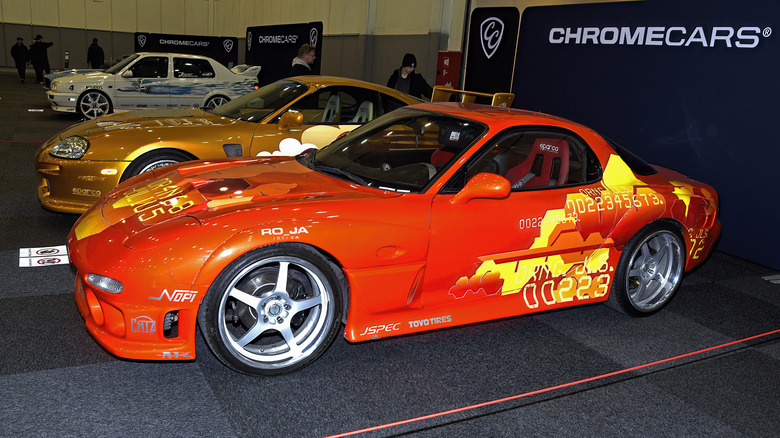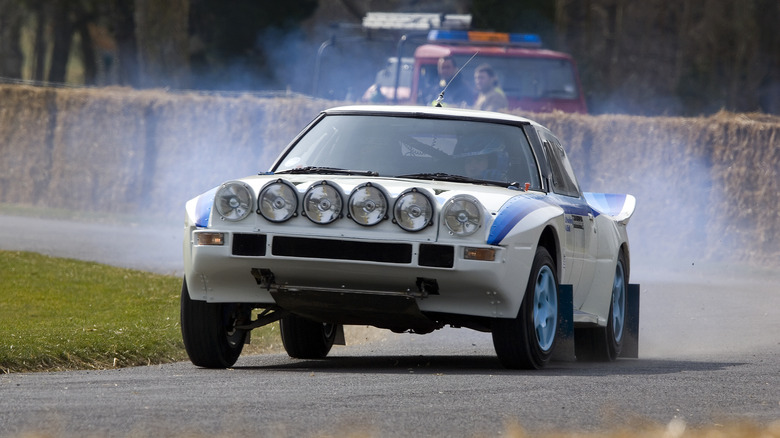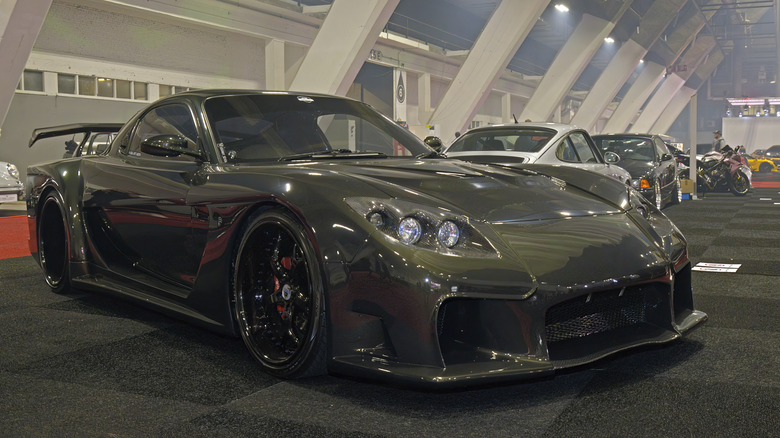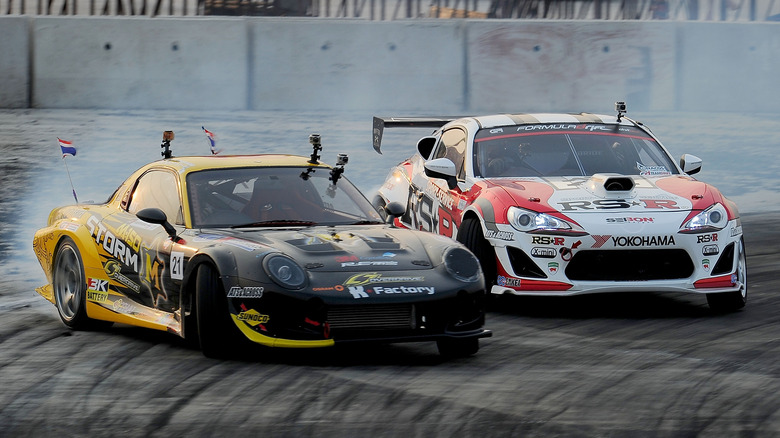Here's What Makes The Mazda RX-7 One Of The Most Iconic Cars In JDM History
You don't have to be a Mazda fan to know that the RX-7 is an iconic car. After its debut in 1978, the car had three successful generations, each one bringing changes to the style and performance. Regardless of the exact RX-7 model, though, it remains one of the most memorable cars from Japan for multiple reasons, ranging from its unique engine to its racing legacy. The RX-7 was special for Mazda, too, because of how well it did in sales. In fact, the car sold more than 500,000 units in the U.S. alone over its lifetime.
In part, this success was due to the RX-7 being a truly affordable sports car. It also helped that the car became part of a big hobbyist scene. For that latter reason, finding an unmodified RX-7 can be a challenge. So, without further ado, let's run down why exactly the Mazda RX-7 became a JDM legend.
The Wankel rotary engine
One of the most obvious things that made the RX-7 iconic was its unique powerhouse, the Wankel rotary engine. The story of this engine goes all the way back to Mazda's early experimentation with Felix Wankel's rotary design, aiming to sidestep tax penalties on larger engines in Japan. This allowed Mazda to offer the power and performance of a larger engine in a compact 1.3-liter package.
It also became the centerpiece of Mazda's sports car legacy. Its size enabled a low and more central placement within the RX-7 chassis, which translated to better handling and balance. Mazda kept improving the RX-7's engine, too; you can see this evolution from the initial 12A engine to the more powerful 13B variants, including turbocharged versions. By the time the third-generation RX-7 rolled out, Mazda had perfected the rotary engine with a sequential twin-turbocharger setup, pushing power levels to compete with far more expensive sports cars. All that being said, if you're buying a Mazda RX-7, there are some things you should know about the rotary engine — it's somewhat notorious for reliability issues and low fuel economy.
[Featured image by J. Lyon via Wikimedia Commons | Cropped and scaled | CC BY-SA 2.5 ]
Iconic designs
The Mazda RX-7 really shows what the 1980s and '90s were all about when it came to cool cars, and that had everything to do with its design. It says something that the car's beloved look has been the main inspiration for the cutting-edge Mazda Iconic SP. The design also played a big role in bringing the RX-7 to the big screen as the star of multiple "Fast and Furious" movies, a role that likely contributed to its late-stage profile in the U.S.
When it first came out in 1978, the RX-7 looked sharp and fast. It also had a unique wedge-shaped front that made it stand out. This wasn't just for show; it also helped the car be more aerodynamic. As time went on, the RX-7 got a new look in 1985 and again in 1992, taking some ideas from fancy European rides along the way. Through all these changes, the RX-7 stayed true to another element that always made it great: being fun to drive.
Performance on a budget
Looking great isn't the only thing the RX-7 has to offer. The car also excelled in the performance department throughout its production run. One major contribution was the car's light weight — sometimes less than 2,500 pounds, depending on the trim. Mazda made sure the engine was placed just right to distribute the weight and make the car balanced and easy to handle, which went a long way, too.
Turbocharging gave the RX-7 a big boost, starting with the FC generation in 1985 and refined in the FD series. Turbocharged variants of the RX-7, especially the FD's sequential twin-turbo setup, provided a significant leap in power, pushing output to 255 hp in the U.S. market. The most advanced RX-7 models could go from 0 to 60 mph in under 5 seconds.
Handling is another big win for the RX-7 thanks to the engine placement and Mazda's tech, including the Dynamic Tracking Suspension System (DTSS) and Auto Adjusting Suspension (AAS) in later models.
Limited and special editions
One look at the list of RX-7 models will tell you that Mazda loved making limited editions. One notable example was the 10th Anniversary RX-7, which featured a crystal white monochromatic paint scheme, an all-black leather interior, and unique 10th-anniversary branding. It's a particularly collectible RX-7, especially considering it was limited to just 1,500 units.
Another significant model was the RX-7 SP, which was introduced in Australia to comply with racing requirements. This RX-7 is even more exclusive, with just 35 units produced. It had features like a carbon fiber nose cone, a spoiler, and a power increase to 274 hp.
There's also the Mazda RX-7 FD, one of the fastest Mazda sports cars ever made. It isn't a special edition, but this third generation saw the release of the "Spirit R" series, the final 1,500 units of the RX-7 in 2002, which combined all the best features from previous special editions. This model included features like cross-drilled brake rotors and was a fitting farewell to a car that made such huge contributions to JDM history. Mazda even referred to this version as the "ultimate RX-7."
Racing heritage
The RX-7 started winning races from the get-go, with a 1-2 class finish at the 24 Hours of Daytona in 1979. This was just the beginning. For seven years straight, it was the top car in its class in the IMSA GTU. It won another big championship, the IMSA GTO, 10 years in a row. These victories helped give the RX-7 a reputation as a great performance car as well as a stylish one.
The RX-7's motorsport achievements extended to Europe as well. Tom Walkinshaw, racing RX-7s, clinched the British Touring Car Championship twice in a row during the early '80s. In Australia, the RX-7, driven by legends like Alan Moffat, secured victories and podium finishes in the Australian Touring Car Championships and the grueling Bathurst 1000. The fact that people love racing the RX-7 even today is a testament to the car's iconic status and its enduring legacy in JDM history.
